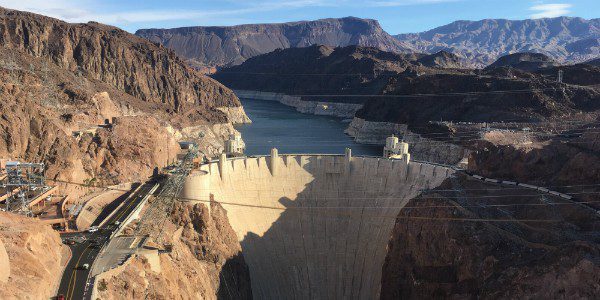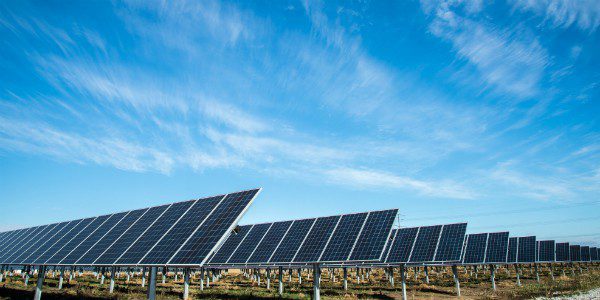THE PRICE GASOLINE IS HIGHER THAN YOU THINK
Water and energy, two of the most essential elements in our modern society, are inextricably linked. In our prior articles regarding the water-energy nexus, we discussed the massive energy demands, and corresponding greenhouse gas impacts, of transporting, treating, and disposing of water in California. For example, the energy used to move, treat, and dispose of water accounts for nearly 20 percent of all electricity used in the Golden State, and more than the entire state of Oregon uses for any purpose. However, the converse of the water-energy relationship is also true: the creation of fuel and energy is water-intensive. A tremendous amount of water is used to mine, extract, produce, and refine most sources of energy.
The Water Supply Landscape
Water scarcity is already a top concern in the southwestern United States, and is expected to intensify with continued economic and population growth, urbanization, droughts, and heat waves due to climate change. The Colorado River, which supplies water to over 40 million people, has been stressed by a 19-year drought.[1] Lake Mead and Lake Powell, the nation’s largest reservoirs, are currently at 41 percent and 40 percent capacity, respectively. Seven states, including California, recently negotiated a drought contingency plan to avert disaster and increase the levels of these reservoirs. As 72 percent of San Diego’s water supply came from the Colorado River between 2012 and 2017, the criticality of water conservation cannot be overstated. As part of these water conservation efforts, intelligent, water-conscious energy production and consumption are essential to our path forward.


The “Water-Cost” of Energy
Over 80 percent of all electricity produced in United States is generated by thermoelectric power plants. These plants typically burn coal, natural gas, oil, or use nuclear fuels to boil water which drive steam turbines and thus generate electricity.[2] Thermoelectric plants require massive amounts of water to cool the steam, such that in 2015, thermoelectric power accounted for over 40 percent of all water withdrawals across the United States.[3] This is why most power plants are located next to large bodies of water. Much of the water used for cooling is returned to its source at a higher temperature than when it was withdrawn, contributing thermal pollution to these waterbodies, which can have grave impacts on aquatic ecosystems (but that’s another issue for another day).[4]
California’s energy production methods and consumption habits differ from much of the rest of the country. Despite having the largest population and economy in the United States, our state’s per capita energy consumption is the second lowest in the country thanks to a temperate climate, and long term energy efficiency policies.[5] California’s renewables portfolio standard requires 60 percent of the state’s energy to come from renewables by 2030, and 100 percent by 2045.[6] In San Diego, approximately 43 percent of electricity currently comes from renewable sources like solar and wind, and a majority of the remainder comes from natural gas fueled plants.[7] These energy sources are generally much less water-intensive than thermoelectric plants elsewhere in the United States. Newer natural gas-fueled plants and many industrial solar operations utilize “closed-cycle” systems (which, to be clear, still use a lot of water, just less than the water used by older, outdated plants), where cooling water is recirculated, while wind turbines and solar photovoltaics require negligible amounts of water to produce energy.[8]


Therefore, water-energy nexus issues related to California’s energy production and consumption center around oil. California’s energy consumption profile is dominated by transportation.[9] Unfortunately, petroleum products are still the predominant energy source for the transportation sector, accounting for about 92 percent of total U.S. transportation energy use in 2018.[10] According to the U.S. Energy Information Administration, California is the largest consumer of motor gasoline in the United States, and almost all of the petroleum consumed in the state is used for transportation.[11] However, California’s ties to oil extend far beyond its car-centric lifestyle. Those who have driven through the state’s tangle of highways have likely noticed the eye-sores of off-shore oil derricks and pumpjacks dotting the landscape. Home to some of the nation’s largest oil-fields, California is the fourth-largest producer of crude oil in the U.S., behind only Texas, North Dakota, and Alaska.[12] Furthermore, California accounts for one-tenth of U.S. refining capacity, behind only Texas and Louisiana.[13]
Oil extraction is water intensive, though the amount of water needed for this process is highly dependent upon the method of extraction used. For example, primary production uses air pressure to force oil to move through rock pores to reach oil wells, and thus uses relatively little water. Researchers at the Lawrence Berkeley National Laboratory (Berkeley Lab) estimate that primary production uses only 0.8 to 2.0 gallons of water per million BTU produced (approximately 0.11 to 0.28 gallons of water per gallon crude oil).[14] However, secondary recovery, also known as “enhanced” oil recovery involves the injection of large quantities of water or steam into a well, and is estimated to use anywhere from 14 to 2,500 gallons of water per million BTU produced (approximately 1.93 to 345.3 gallons of water per gallon of crude oil).[15] As California has had a moratorium on leasing federal public land and mineral estates to oil companies for the past five years, most oil extraction operations in the state are older, and thus more likely to require greater quantities of water per barrel of oil produced. California produced 7,308,000,000 gallons of oil in 2017.[16]
Refining crude oil is also a water-intensive process. In the United States, refining one gallon of oil requires on average approximately 1.5 gallons of water. The Berkeley Lab study estimates that, when combined with the water needed to extract each gallon of oil, between 3.6 and 7.0 gallons of water are used to produce and refine one gallon of crude oil in the United States. For oil extracted in California, this likely reflects a conservative estimate given the more water-intensive extraction methods employed in the state, which can require orders of magnitude more water than oil extracted using primary production methods. As such, the total amount of water required to produce a gallon of refined petroleum could be much higher in California.
Your Commute May Use More Water Than Your Shower
The San Diego Association of Governments (“SANDAG”) estimates that the average vehicle miles traveled (“VMT”) per capita per day will be 23.6 miles in 2020. Estimates indicate that a total of 3/4 of a gallon of water is required to extract, refine and transport the petroleum used to drive one mile.[17] Thus, the average daily commute in San Diego uses roughly 17.7 gallons of water. By comparison, the average American shower uses only 17.2 gallons of water.[18] Furthermore, the single highest use of water in the average home is toilet flushing. Yet in a home with ultra-low-flow toilets, the average daily water use per person only is 9.1 gallons.[19] Hence, the commute for many San Diegans may consume more water than the highest source of water usage in their home.
Less is More
As discussed in our prior water-energy nexus articles, reducing waste is cheaper and easier than increasing supply. The less gasoline you burn, the more water you save. On an individual level, there are a number of strategies you can employ to reduce your fuel use and related water footprint: seek out carpool opportunities; take public transportation; walk or ride a bike whenever possible; keep your vehicle properly maintained to ensure it’s running efficiently; and for your next vehicle, consider a hybrid or electric (you know you want that Tesla).


In the transportation sector more broadly, a reduction in fuel-related water consumption can be achieved by both improving vehicle efficiency standards, and by reducing VMT. Although biofuels can reduce carbon emissions associated with burning fossil fuels, the water requirements for producing biofuels significantly outweigh that of petroleum extraction. For example, on average, 14,000 gallons of water are required to produce just one gallon of biodiesel from soybeans.[20] However, there are there are many policies and region-wide actions that have vast potential to reduce VMTs in the San Diego region. Coastkeeper supports and advocates for intelligent policies that implement improved public transportation, compact growth near transit centers, and well-planned communities so that walking, biking, and public transportation are feasible, attractive options. We partner with other local organizations and stakeholders that bring additional expertise to the table, and leverage our relationships with elected officials to advocate for and enact such policies throughout San Diego. Through strategic collaboration and effective advocacy, we can move the needle on reducing consumption of both water and energy in our region. Faced with an uncertain future of intensifying climate impacts, thoughtful, intentional action to lessen our footprint, reduce waste, and improve efficiency in both the water and energy sectors is critical, and Coastkeeper is committed to making sure there is a strong environmental voice in each room where decisions about our region’s water and energy future are being made.
Be sure to check out these additional posts of the water-energy nexus to learn more:
Where Water And Energy Collide
The Water-Energy Nexus: A Deeper Look
—
[1] https://www.azcentral.com/story/news/local/arizona-environment/2019/05/20/colorado-river-drought-deal-signed-hoover-dam-water-challenges-contingency-plan/1194657001/.
[2] https://www.eia.gov/energyexplained/index.php?page=electricity_in_the_united_states. Gas: 35%, Coal: 27%, Nuclear: 19%. Total: 81%.
[3] https://pubs.usgs.gov/fs/2018/3035/fs20183035.pdf.
[4] https://iopscience.iop.org/article/10.1088/1748-9326/11/10/104011/pdf.
[5] https://www.eia.gov/state/analysis.php?sid=CA.
[6] Cal. Public Utilities Code §399.11 et seq.; Cal. Public Resources Code §25740 et seq.; Assembly Bill 327 (2013); Senate Bill 350 (2015); Senate Bill 100 (2018).
[7] http://www.sdgenews.com/article/how-natural-gas-fuels-san-diegos-power-plants
[8] https://cloudfront.escholarship.org/dist/prd/content/qt5pr6r5h6/qt5pr6r5h6.pdf?t=mqvmjo
[9] https://www.eia.gov/state/analysis.php?sid=CA#11
[10] https://www.eia.gov/energyexplained/?page=us_energy_transportation
[11] https://www.eia.gov/state/analysis.php?sid=CA#11.
[12]Id.
[13] Id.
[14] https://cloudfront.escholarship.org/dist/prd/content/qt5pr6r5h6/qt5pr6r5h6.pdf?t=mqvmjo
[15] Id.
[16] file:///C:/Users/SDCK/Downloads/2017_Preliminary_Annual_Report.pdf.
[17] https://www.watercalculator.org/save-water/gasoline/; https://pubs.acs.org/doi/full/10.1021/es800367m.
[18] https://www.home-water-works.org/indoor-use/showers
[19] https://www.home-water-works.org/indoor-use/toilets
[20] https://cloudfront.escholarship.org/dist/prd/content/qt5pr6r5h6/qt5pr6r5h6.pdf?t=mqvmjo















